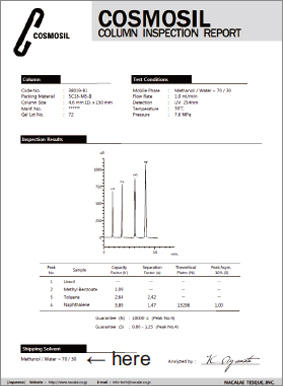Which mobile phase can be used for LC/MS or ELSD detector?
Q8. Which mobile phase can be used for LC/MS or ELSD detectors?
Volatile solvents should be used for LC/MS and ELSD. Phosphoric acid buffers cannot be used.
| Regent | Usable solvent / Additive | |
|---|---|---|
| Solvent | Methanol, ethanol, acetonitrile, water | |
| pH Adjusting Reagent | Acetic acid, formic acid, trifluoroacetic acid, ammonia solution, ammonium acetate, ammonium formate | |
| Ion-Pairing Reagent | Dibutylamine, triethylamine | |
A small amount of non-volatile solvent, such as DMSO (dimethylsulfoxide) or DMF (dimethylformamide) can be used if they are mixed with methanol or acetonitrile. However, if the concentration becomes higher, detection sensitivity may decrease.
Q9. What should I pay attention to when using ion-pairing reagents?
- Concentration of ion-pairing reagent should be 5-10 mmol/l.
- Use mobile phase of pH 7 for acidic ion-pairing reagents and pH 2.5 for basic ion-pairing reagents.
- Thoroughly equilibrate column before use.
Notes;
- Higher ion pair concentration will result in longer retention time.
- Adjust pH of mobile phase so that the sample is well ionized.
- Longer equilibration time is necessary compared to mobile phases without ion-pairing reagents.
- Use a column exclusively for ion-pairing reagents, as it is difficult to eliminate them from the column.
Q10. What flow direction should I use for the mobile phase?
Pump mobile phase in the direction specified on the column label. Pumping mobile phase in the reverse direction may deteriorate the packing material and decrease theoretical plates. Furthermore, impurities previously adsorbed on the column tip may loosen, causing noise and contaminated detector and tubing.
Q11. What is the recommended column oven temperature?
The maximum temperature is 60°C, but the recommended temperature range is 20-50°C. For SFC columns, keep the temperature below 50°C
Caution;
- Operating at high temperature under alkaline or acidic conditions may shorten column lifetime.
- Maintain constant temperature during analysis as column temperature affects retention time. Generally, higher temperature lowers column pressure and shortens retention time.
Q12. What is the shipping solvent?
It depends on the column type. Please refer to the inspection report inside each column box.










